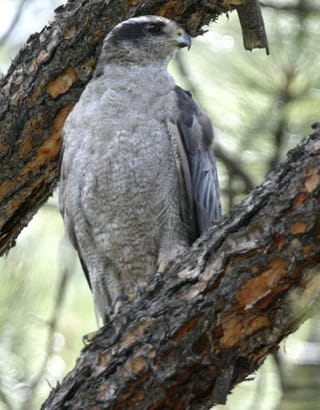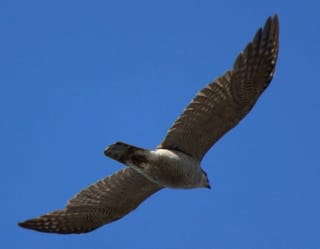Initially this guide displays common birds of all types that are flying right now in our area. Use the selectors below to view rare birds, view birds flying any time, restrict the output to a certain shape of bird, or search by name.
New Mexico is on the western edge of the Central Flyway which is one of the major migration pathways between north and south for birds traveling between breeding and wintering grounds along the Rocky Mountains. This has resulted in the state having an incredible diversity of birds with over 550 different species reported. A little more than half of this number are sighted annually on the Pajarito Plateau. Some of these birds are full-time residents, some migrate here for a few weeks or months, and other are only seen briefly as they pass through the region.
This guide features many of the birds known to frequent Los Alamos county by when they are likely to be seen in the area. You can get additional information on local birds by joining PEEC Birders or going to the eBird website. eBird also includes lists of rare bird sightings and birding hot spots.
Bird References
Birdweb
Cornell Lab of Ornithology
eBird
eNature
Institute for Bird Populations
National Audubon Society
New Mexico Ornithology Society
What Bird
xeno-canto
Subject Area Experts (all guides)
Steve Cary (butterflies)
Beth Cortright (insects)
Terry Foxx (invasive plants)
Leslie Hansen (mammals)
Richard Hansen (fish, mammals)
Dorothy Hoard (butterflies, trees)
Chick Keller (flowers, herbarium)
Shari Kelley (geology)
Kirt Kempter (geology)
Garth Tietjen (reptiles)
David Yeamans (birds)
Web Development and Content Management
Pat Bacha
Jennifer Macke
Graham Mark
Akkana Peck
Contact
Please contact us for local nature questions and sightings. We welcome comments, corrections, and additions to our guides.
For more information about local nature, please visit our Nature Blog or subscribe to PEEC This Week.
Make Selection
 Photo: Richard Reynolds  Photo: adult by scops  Photo: immature by Marion L. Stelts |  Northern GoshawkNOGO (Accipiter gentilis)Family: Accipitridae (Hawks and Eagles) Size: 20 - 26 in (51 - 66 cm) Flies: Jan 01 - Dec 31 Morphology: adults are dark slate gray above and paler underneath with a dark head and white stripe over the eye; females are larger than males; immatures are brown and streaky with dark tail bands and yellow eyes Status: native; locally common Food source: mostly birds and small mammals such as grouse and squirrels; also eats snakes and some insects Habitat: forests (deciduous and coniferous) with intermediate to heavy canopy coverage, scrub, farmlands, woodland edges The Northern Goshawk has a relatively short, broad wings, a long tail and a relatively large bill. It is an expert at the surprise attack and prefers to hunt by watching for prey perched quietly about half-way up a tree, often moving from one perch to another. When prey is spotted, the bird will put on an extra burst of speed, plunging through tangled branches in pursuit. Goshawks only vocalize during breeding and nesting season. When calling while perched, the birds often move their heads from side-to-side to throw the sound. Males provide food for the nesting females starting before the eggs are laid. Nests are built in a major fork up in a tree. They are often reused so that more material is added each year making the them quite large. Both parents will boldly defend the nest, diving and nipping at intruders including humans. Eggs hatch approximately 35 days after laying and the young fledge at 5 to 6 weeks. Info Photos Distribution Frequency |
